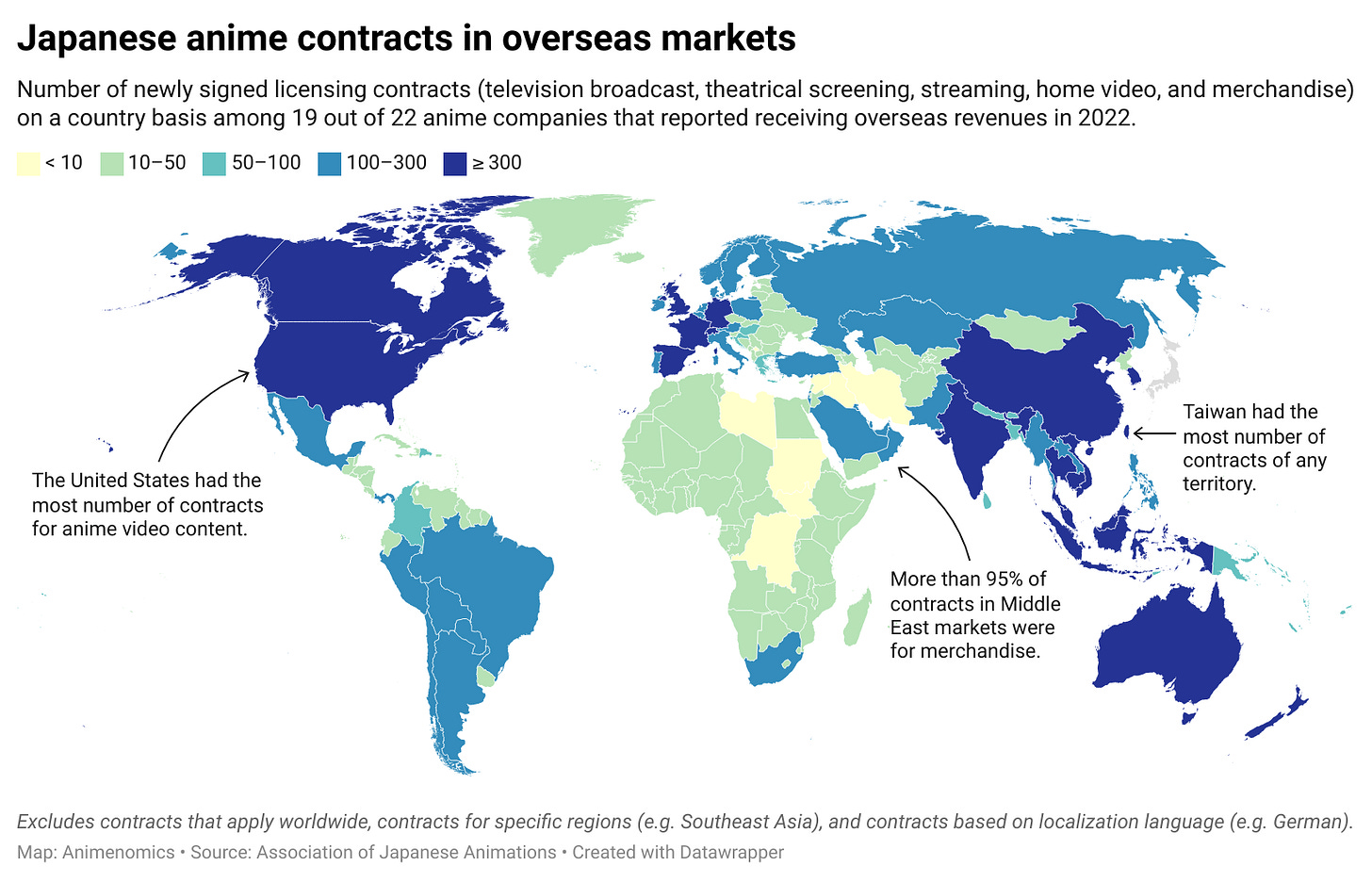Anime licenses surge in post-pandemic boom
Plus: Survey reveals gender gap in anime production; Sony drops satellite broadcasting for anime; 'One Piece' puts spotlight on anime reboots; and more
This is your weekly Animenomics briefing, covering the business of anime and manga. Today is Wednesday, December 20, 2023.
Programming note: Animenomics will be taking a break for the next two weeks. Our first newsletter issue of the new year will be on Wednesday, January 10, 2024.
Anime licenses surge as world emerged from pandemic
New contracts between Japanese anime companies and overseas licensees surged last year, according to industry survey data newly published by the Association of Japanese Animations (AJA) trade group.
Why it matters: The AJA’s latest annual Anime Industry Report provides the first complete picture of anime’s global ascent in 2022 as the world emerged from the COVID-19 pandemic.
It also confirms a narrower analysis by credit reporting agency Teikoku Databank in the summer that found more anime companies doing business with overseas partners than ever before.
By the numbers: Nearly 23,000 contracts for anime content and products were signed last year, six times the number from 2021 and 40 percent more than in 2020.
Out of 22 anime planning and production companies that reported overseas revenues, 19 shared contract details with the report’s authors.
Merchandise-only deals made up 70 percent of new contracts thanks to pent-up demand by consumers who watched more anime during lockdowns.
Distributors around the world were also on the hunt for the next hit anime as they signed nearly 7,000 contracts for video content, more than double from the previous year.
Zoom in: Streaming anime had a high penetration rate in overseas markets. More than 84 percent of video content contracts included a streaming license.
Viewers were more likely to find anime on streaming platforms and on home video, with licensees executing four out of five streaming video contracts and three out of four home video contracts.
Only one in three overseas television and theatrical distribution contracts were executed.
Between the lines: The report’s authors note that while overseas revenues grew 11 percent on a yen basis, it actually shrank 7.3 percent on a dollar basis.
The authors point the yen’s depreciation against the United States dollar, but they did not rule out the possibility that anime actually lost market share to other types of video content globally.
Top anime films have a gender gap in decision-making
There is a stark gender gap between men and women who hold leadership roles on the production staff of Japan’s best-selling anime films, an analysis by the non-profit Japanese Film Project found.
Why it matters: This is the first time the Japanese Film Project (JFP) has included anime films in its survey. Previous iterations in 2021 and 2022 only evaluated live-action film staff.
By the numbers: JFP looked at the production credits of anime films that earned at least ¥1 billion (US$7 million) in the Japanese box office in 2022 and found that 46 percent of film staff were women.
In lead positions like director, writer, animation director, music director, character designer, and director of photography, one in three were women.
Women only accounted for one in four production committee company representatives and one in five anime producers.
On the other hand, more than half of positions doing creative work like key animation and background art were held by women.
Yes, but: “When discussing the categories of ‘staff’, it is not possible to simply compare the proportion of women in, for example, production management jobs employed by companies to animator jobs, which are often freelance,” Yokohama National University professor Akiko Sugawa-Shimada wrote in the report.
Women in freelance roles are more likely work on multiple productions simultaneously, leading to the impression of more women representation even though the reality may be different.
Zoom out: As the Japanese entertainment industry copes with allegations of sexual abuse in recent years, there is growing interest in highlighting gender and power disparities in the country.
Meiji University professor Yukari Fujimoto also told attendees of this year’s International Manga and Anime Festival Reiwa Toshima that while there is no country where content aimed at women is as developed as in Japan, there is still an implicit assumption that content is primarily aimed at men.
Be smart: Despite the pioneering nature of the survey, the data set evaluated by Japanese Film Project is quite limited.
Only 14 anime films met the box office earnings threshold set in the survey, fewer than the total of 76 anime films released last year and even much fewer than the more than 300 television anime productions.
Clippings: Sony exits satellite anime broadcast business
Sony and other shareholders are selling the satellite television networks Animax and Kids Station to electronics retailer Nojima, exiting all anime distribution on terrestrial and satellite broadcasting. (Animation Business Journal)
Catch up quick: Sony sold Animax’s operations in Southeast Asia and South Korea in 2020. The company is expected to consolidate anime distribution for all markets outside Japan on the Crunchyroll streaming platform.
A new digital manga service by an alliance of four companies may launch in the United States at the end of 2024. It will be modeled after Tokyo-based Akatsuki’s HykeComic manga app, which has a track record of releasing vertically-scrolling webtoons. (Animation Business Journal)
Avex subsidiary Anime Times has launched India’s first dedicated anime channel on Amazon Prime Video, setting its add-on subscription price at ₹899 (US$10.80) a month. (Variety)
Video game developer Level-5, known for titles like Yo-kai Watch and Inazuma Eleven, showcased how it incorporates generative AI technology in video game and anime production workflows in a presentation to the Japanese government. (4Gamer)
‘Gundam’ creator: Streamers profit from anime industry
“The people who make the most money in the industry are actually not the production studios or the investors. It’s the streaming video companies. Do those so-called ‘platformers’ really have a mechanism in place to legitimately pay for the intellectual property rights of their works? That’s what I’m most concerned about.”
— Yoshiyuki Tomino, Mobile Suit Gundam anime franchise creator
Context: Weekly Toyo Keizai interviewed Tomino about the current state of the anime industry for the business magazine’s year-end issue, where he alludes to a push for streaming video companies to provide more transparency.
Zoom out: Last week, Netflix released its first ever engagement report that details viewership data for more than 18,000 titles on its platform, including dozens of anime titles.
New ‘One Piece’ series puts spotlight on anime reboots
One Piece manga publisher Shueisha’s announcement of an anime reboot for the series last weekend is raising eyebrows among industry watchers and fans of the work for its unusual arrangement.
Driving the story: WIT STUDIO is adapting One Piece’s first story arc, East Blue, as a new anime series titled The One Piece to be distributed by Netflix.
IG Port, the anime production company that owns WIT STUDIO, has already seen its share price in the Tokyo Stock Exchange rise 14 percent this week.
Why it matters: A reboot being produced while an existing anime adaptation is still ongoing is unusual for the anime industry.
Industry watchers point to The One Piece’s unusual production structure where Toei Animation, which animates and funds the existing One Piece anime, is also an investor on the commitee of The One Piece.
Toei Animation is no stranger to reboots of its anime properties, as it has done with Sailor Moon Crystal and Digimon Adventure, but the original series for those properties ended decades ago.
What they’re saying: Netflix’s press release says The One Piece utilizes “cutting-edge visual technology to reimagine Luffy’s adventures”.
This statement is not lost to viewers who point out that WIT STUDIO and Netflix collaborated on an experimental anime short that used generative AI to create background art earlier this year.
Our thought bubble: Given that Toei Animation’s East Blue adaptation is nearly 15 years old, producers may be using the success of Netflix’s live-action One Piece as launchpad to reintroduce the story to today’s anime audience.
What we’re watching: Whether producers will hire a new generation of voice actors for The One Piece.
Animenomics is an independently-run and reader-supported publication. If you enjoyed this newsletter, consider sharing it with others.






